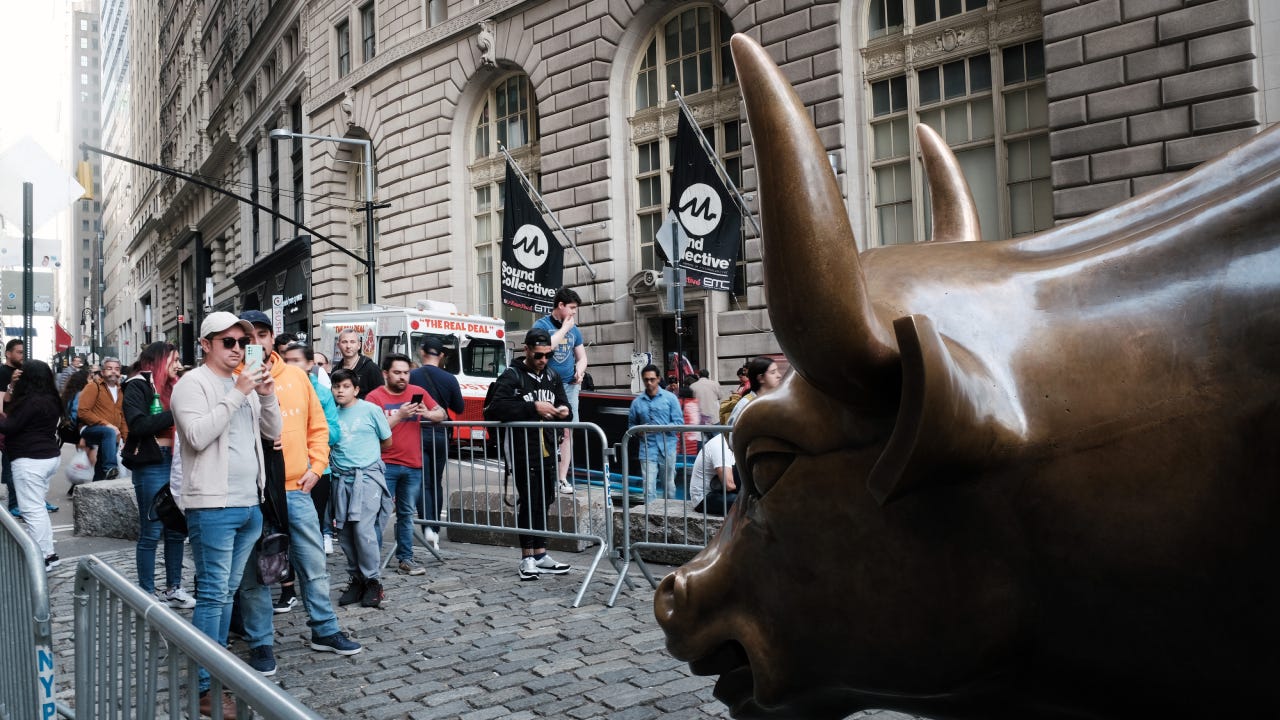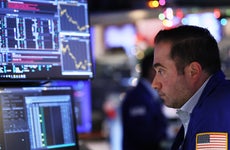Survey: Here’s when pros see the next bull market arriving and whether crypto can make a comeback

The Bankrate promise
At Bankrate we strive to help you make smarter financial decisions. While we adhere to strict , this post may contain references to products from our partners. Here's an explanation for .
Stocks fell relentlessly through most of 2022, as the Federal Reserve promised to raise interest rates aggressively to fight runaway inflation — and followed through with hawkish action. Now with short-term rates above long-term rates — a so-called yield curve inversion — experts are predicting further weakening in the economy. While a recession has yet to begin, investors are wondering when stocks might rise again.
Bankrate surveyed investing experts as part of its Market Mavens Fourth Quarter 2022 survey, asking them when the next bull market, a period of rising stocks, would begin. We also asked them about the recent plunge in the cryptocurrency markets and what that means for investors.
Cryptocurrency has plunged even more precipitously than stocks have, as investors quickly became more risk-averse as interest rates rose. High-profile blow-ups and outright fraud have dogged the sector this year, too, and this speculative investment has been a big loser in 2022.
Forecasts and analysis:
This article is one in a series discussing the results of Bankrate’s Market Mavens fourth-quarter survey:
- Pros expect modest rally in stocks over the next year despite growing recession fears
- 10-year Treasury yield to rise even higher over the next year, experts say
- Here’s when pros see the next bull market arriving and whether crypto can make a comeback
Here’s when experts see the next bull market starting
It hasn’t been much fun to be a stock investor in 2022, with stocks falling throughout the year in response to rising rates and an uncertain time frame for when the Federal Reserve would pause on hiking rates. Even with the Fed acting so aggressively, inflation has remained stubbornly high.
With rising rates, the yield curve has inverted, signaling that a recession is on the way. While a recession has yet to materialize, many investors see it as a foregone conclusion. But investors are a forward-looking bunch, and many are looking for when the next bull market will start.
Here’s when the next bull market is expected to begin, according to the experts surveyed:
- 7 percent said: “A new bull market has already begun.”
- 21 percent said: “A new bull market may begin before July of next year (or around the next six months).”
- About 36 percent said: “A new bull market may begin in the second half of next year (2023).”
- 21 percent said: “It may be 2024 before a new bull market begins.”
- 14 percent said: “It may be sometime after 2024 when a new bull market begins.”
That distribution spreads pretty wide over the next 18 months or so, but a total of 57 percent said a bull market would begin again in 2023, whether in the first half or second half of the year.
But what’s the thinking behind the experts’ predictions?
Those expecting the bull market to return in the first half of 2023 include Hugh Johnson, chief economist, Hugh Johnson Economics, though even he admits to being a bit overly optimistic.
“Prospects for an economic or earnings recovery are likely to improve or ‘turn for the better’ during a hard landing or recession in Q1 and Q2 2023,” says Johnson. “Hence, I anticipate a more positive financial market environment beginning to unfold in Q1 or Q2, even though that may sound like and indeed be wishful thinking.”
Another proponent of a first-half return of a bull market is Sameer Samana, senior global market strategist, Wells Fargo Investment Institute. Samana says, “We see a recession in the first half of 2023, which will bring inflation down, and allow the Fed to cut rates in the second half. That should allow equities to bottom in the first half and begin looking toward an economic recovery.”
The bull market will return in the second half of 2023, says another group of experts, including Patrick J. O’Hare, chief market analyst, Briefing.com.
“A new bull market should begin when there is confidence in the notion that earnings estimates have been cut enough, thereby drastically reducing investors’ angst about buying into a value trap, and when there is confidence that the Fed is going to start cutting rates,” says O’Hare. “We think that starts to come to fruition in the second half of 2023.”
Add Michael Farr, CEO, Farr, Miller & Washington to this group expecting a second-half pick-up, though not without caveats.
“This is a bit too precise a period,” says Farr. “Early 2024 is in the realm too, but stocks typically begin their recovery after the Fed stops tightening.”
Sam Stovall, chief investment strategist, CFRA Research, also anticipates a second-half time frame for a turnaround and expects a recession to materialize in the near term. But Stovall does not see it hitting the 40 percent or more drawdowns that some infamous bear markets such as 2007-2009 saw.
But other experts expect the start of a new bull market to drag into 2024, including Charles Lieberman, managing partner and chief investment officer, Advisors Capital Management.
“The market is mispriced if the Fed continues raising interest rates as they have suggested and recent economic data implies is necessary,” says Lieberman. “Inflation is not likely to moderate quickly, so rates have to get higher and stay higher for longer. So, the rate reductions needed to unleash the economy likely need to wait until 2024.”
But with a recession having yet to (officially) begin, inflation remaining high and the Fed promising further rate increases over the coming months, if not longer, a bull market may not be quite ready to emerge, even if investors are more than ready for one.
What’s the future of cryptocurrency?
If stocks are risky, then cryptocurrencies – generally with no backing by assets or cash flow of an underlying entity – are highly speculative. And as the Fed raised interest rates in 2022, crypto assets plunged quickly. Combine that drop with the blow-ups of some notable crypto trading firms, including FTX, as well as some outright fraud, and it’s no wonder investors are skittish.
Bankrate asked the investing experts for their opinion on cryptocurrency and how this year’s crash impacts the long-term future of what some are calling an emerging asset class. Overall, these experts took an exceptionally dim view of digital currencies.
“The investors that got hurt deserved it,” says Marilyn Cohen, CEO, Envision Capital. “They drank the crypto Kool-Aid and believed the hype that it was a store of value. It was made up out of nothing and is worth nothing.”
“The crash in crypto is showing people what they are founded on – nothing at all,” says Kim Forrest, chief investment officer and founder, Bokeh Capital Partners.
Farr echoed many of these sentiments: “Bereft of any intrinsic value or fiat, cryptocurrencies rely on whatever the next buyer is willing to pay to determine value. As sentiment has turned negative, so have prices paid. When sentiment turns, I believe crypto values will recover, too. These are exceptionally speculative investments.”
Lieberman sees this year’s crash as a “major blow to crypto.”
“The speculators will continue to speculate, but this is quite far from becoming a mainstream asset. The risks remain elevated,” he says.
Meanwhile, one investor points to the fact that the trouble in crypto assets – which plunged in total value from around $3 trillion in 2021 to less than $1 trillion at the end of 2022 – has largely had no spillover effects on other traditional financial markets.
“Fortunately, trouble in crypto has tended to stay in crypto,” says Dec Mullarkey, managing director, SLC Management. “But the risk is that continued stress forces those affected to liquidate traditional assets to cover losses which increases volatility in other markets. For now, there appears to be little knock-on to broader markets.”
Yet one investor struck a positive note for cryptocurrency. Sameer Samana of Wells Fargo says: “We think the technology is promising and the shake-out will be positive in the long run for the stronger participants, much like the internet companies in the late ‘90s/early ’00s.”
Methodology
Bankrate’s fourth-quarter 2022 survey of stock market professionals was conducted from Dec. 1-9 via an online poll. Survey requests were emailed to potential respondents nationwide, and responses were submitted voluntarily via a website. Responding were: Jim Osman, founder, The Edge Group; Dec Mullarkey, managing director, SLC Management; Sam Stovall, chief investment strategist, CFRA Research; Michael Farr, CEO, Farr, Miller & Washington; Hugh Johnson, chief economist, Hugh Johnson Economics; Patrick J. O’Hare, chief market analyst, Briefing.com; Chuck Carlson, CFA, CEO, Horizon Investment Services; Louis Navellier, CIO, Navellier & Associates, Inc.; Kim Forrest, chief investment officer/founder, Bokeh Capital Partners; Charles Lieberman, managing partner and chief investment officer, Advisors Capital Management; Kenneth Chavis IV, CFP, senior wealth manager, LourdMurray; Sameer Samana, senior global market strategist, Wells Fargo Investment Institute; Brad McMillan, chief investment officer, Commonwealth Financial Network; Marilyn Cohen, CEO, Envision Capital.
Editorial Disclaimer: All investors are advised to conduct their own independent research into investment strategies before making an investment decision. In addition, investors are advised that past investment product performance is no guarantee of future price appreciation.
Related Articles


Survey: Experts predict stocks will rise less than 4% over coming year

Survey: Pros expect modest rally in stocks over the next year despite growing recession fears
